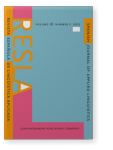Análisis discursivo del ciberconsejo en el género foro virtual de discusión/consulta médica no especializada
The present research, firstly, aims to determine the global structure of the virtual discussion forum/unspecialized medical appointment genre from the analysis of its superstructure. The pattern of the genre presents a tripartite division in which three types of postings succeed each other: problem messages, advice messages and thanks messages. Secondly, the study of the sections and movements that establish the formal structure of these types of messages is completed with the description of the macrostructural level, in which the content or semantic structure of textual productions is covered, without sacrificing the functional exponents and the microstructural supports that contribute to its elucidation.
Article language: Spanish
References
Anderson, T., & Kanuka, H
(
1997)
On-line forums: New platforms for professional development and group collaboration.
Journal of Computer-Mediated Communication, 3(3), 121–135.

Baron, N.S
(
1998)
Letters by phone or speech by other means: The linguistics of email.
Language and Communication, 18(2), 133–170.


Baron, N.S
(
2000)
Alphabet to email. Londres: Routledge.


Baron, N.S
(
2003)
Why e-mail looks like speech: Proofreading, pedagogy and public face. En
J. Aitchinson &
D. Lewis (Eds.),
New media language (pp. 102–113). Londres: Routledge.

Calsamiglia, H., & Tusón, A
(
1999)
Las cosas del decir: Manual de análisis del discurso. Barcelona: Ariel.

Crystal, D
(
2001)
Language and the Internet. Cambridge: Cambridge University Press.


Gaik, F
(
1992)
Radio talk-show therapy and the pragmatics of possible worlds. En
A. Duranti &
C. Goodwin (Eds.),
Rethinking context: Language as an interactive phenomenon (pp. 271–290). Cambridge: Cambridge University Press.

He, A.W
(
1994)
Withholding academic advice: Institutional context and academic practice.
Discourse Processes, 18(3), 297–316.


Heritage, J., & Sefi, S
(
1992)
Dilemmas of advice: Aspects of the delivery and reception of advice in interactions between health visitors and first-time mothers. En
P.D. Drew &
J. Heritage (Eds.),
Talk at work: Interaction in institutional settings (pp. 359–417). Cambridge: Cambridge University Press.

Hutchby, I
(
1995)
Aspects of recipient design in expert advice-giving on call-in radio.
Discourse Processes, 19(2), 219–238.


Hymes, D
(
1974)
Foundations of sociolinguistics: An ethnographic approach. Filadelfia: University of Pennsylvania Press.

Instituto Cervantes
(
2006)
Plan curricular del Instituto Cervantes.Niveles de referencia para el español. Madrid:Instituto Cervantes, Biblioteca Nueva.
[URL].

Leppänen, V
(
1998)
The straightforwardness of advice: Advice-giving in interactions between Swedish district nurses and patients.
Research on Language and Social Interaction, 31(2), 209–239.


Locher, M.A., & Hoffmann, S
(
2006)
The emergence of the identity of a fictional expert advice-giver in an American Internet advice column.
Text & Talk, 26(1), 69–106.


Martín Peris, E
. (coord) (
2008)
Diccionario de términos clave de ELE. Madrid: Instituto Cervantes-SGEL.

Morrow, P.R
(
2006)
Telling about problems and giving advice in an Internet discussion forum: Some discourse features.
Discourse Studies, 8(4), 531–548.


Murray, D.E
(
1991)
The composing process for computer conversation.
Written Communication, 8(1), 35–55.


Murray, D.E
(
2000)
Protean communication: The language of computer-mediated communication.
Tesol Quarterly, 34(3), 397–421.


Olmedo, J
(
2001)
Lengua y escritura en Internet: Tres décadas de “red-acción”. En
Á. Martín Municio (coord.),
Nuevas fronteras del español. II Congreso Internacional de la Lengua Española. El Español en la Sociedad de la Información. Valladolid, 16-19 de octubre de 2001.
[URL].

Pérez Sabater, C
(
2007)
Los elementos conversacionales en la comunicación escrita vía Internet en lengua inglesa. Tesis doctoral. Castellón: Universitat Jaume I.
[URL].

Pilnick, A
(
1999)
‘Patient counseling’ by pharmacists: Advice, information, or instruction? Sociological Quarterly, 40(4), 613–622.


Pilnick, A
(
2001)
The interactional organization of pharmacist consultations in a hospital setting: A putative structure.
Journal of Pragmatics, 33(12), 1927–1945.


Posteguillo, S
(
2003)
Netlinguistics. Castellón: Universitat Jaume I.

Ridao Rodrigo, S., & Rodríguez Muñoz, F.J
(
2013)
Problemas de puntuación en contextos digitales: análisis de comentarios en foros de YouTube.
Anuario de Estudios Filológicos, 361, 83–105.

Rodríguez Muñoz, F.J
(
2012)
Los déficits pragmáticos en el discurso oral de niños con síndrome de Asperger. Tesis doctoral. Almería: Universidad de Almería.

Rodríguez Muñoz, F.J
(
2013a)
Evaluación pragmática de niños con síndrome de Asperger. Múnich: Lincom Verlag.

Rodríguez Muñoz, F.J
(
2013b)
Pilot assessment of nonverbal pragmatic ability in people with Asperger syndrome.
Psychology of Language and Communication, 17(3), 279–294.


Sarangi, S., & Clarke, A
(
2002)
Zones of expertise and the management of uncertainty in genetics risk communication.
Research on Language and Social Interaction, 35(2), 139–171.


Searle, J.R
(
1969)
Speech acts: An essay in the philosophy of language. Cambridge: Cambridge University Press.


Silverman, D
(
1997)
Discourses of counselling: HIV counselling as social interaction. Londres: Sage.

van Dijk, T.A
(
1980)
Macrostructures: An interdisciplinary study of global structures in discourse, interaction, and cognition. Hillsdale, NJ: Lawrence Erlbaum.

Vehviläinen, S
(
1999)
Structures of counselling interaction: A conversation analytic study of counselling in career guidance training. Helsinki: University of Helsinki, Department of Education.

Vehviläinen, S
(
2001)
Evaluative advice in educational counselling: The use of disagreement in the ‘stepwise entry’ to advice.
Research on Language and Social Interaction, 34(3), 371–398.


Vehviläinen, S
(
2003)
Avoiding providing solutions: Orienting to the ideal of students’ self-directedness in counselling interaction.
Discourse Studies, 5(3), 389–414.


Wood, A., & Smith, M
(
2001)
Online communication: Linking technology, identity, and culture. Mahwah, NJ: Lawrence Erlbaum.


Yus, F
(
2001)
Ciberpragmática. Barcelona: Ariel.

Yus, F
(
2010)
Ciberpragmática 2.0. Nuevos usos del lenguaje en Internet. Barcelona: Ariel.

Cited by
Cited by 1 other publications
Fernández-Vallejo, Ana M.
This list is based on CrossRef data as of 14 june 2024. Please note that it may not be complete. Sources presented here have been supplied by the respective publishers.
Any errors therein should be reported to them.
